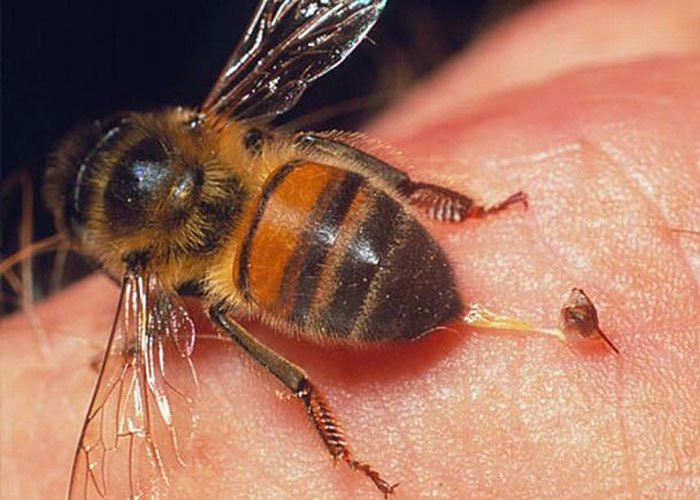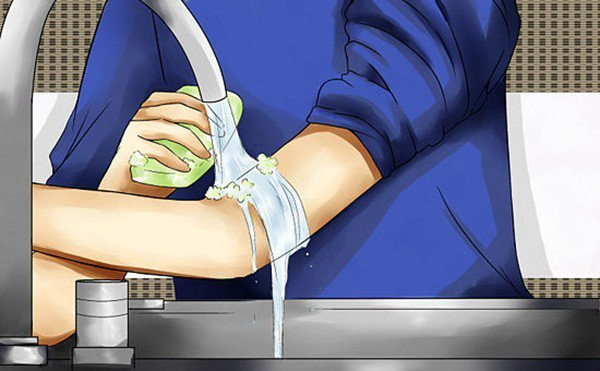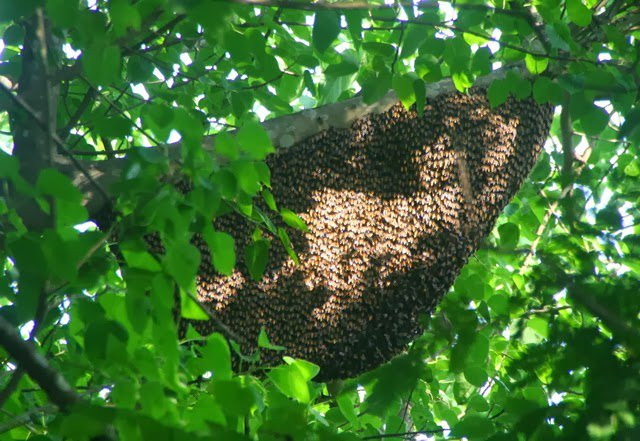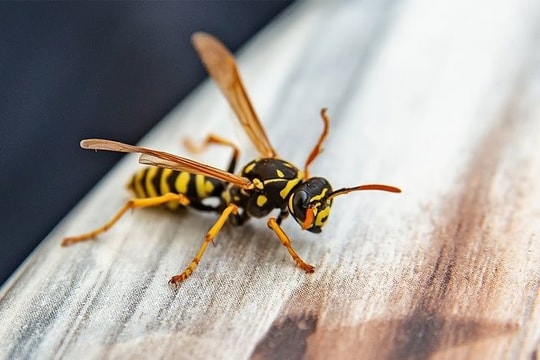How to treat bee stings
(Baonghean.vn) - Being stung by a bee can cause sharp pain, swelling, and can lead to poisoning and even death if not treated promptly. So, what should you do and how should you give first aid when stung by a bee?
» Man catching bees dies 30 minutes after being stung by bees
 |
| Bee sting wound |
Our country has many types of bees, the types of bees that often cause poisoning are hornets, wasps, honeybees and some unknown types of bees in mountainous areas. Hornets, wasps and some types of bees in mountainous areas are very poisonous and dangerous.
Identification and symptoms of bee sting poisoning
Honeybee:The last foot segment (3rd foot) is larger and carries pollen (pollen basket). When burned, it leaves a stinger and the nest has honey.
Bees love(rafter bees) make large nests on high tree branches and cliffs. The nests hang down like water blisters. The bees are large and very ferocious.
Our country currently has 5 native bee species (domestic bees, honeybees, red fly bees, black fly bees and rock bees) and bees imported from foreign countries. In general, honeybees are docile (except honeybees).
Symptoms after being stung:
Pain and swelling at the sting site. Burning dangerous areas (head, face, neck): can cause difficulty breathing, eye damage + Allergy: rash, red skin all over the body, difficulty breathing, allergic shock (rapid, weak pulse, low blood pressure).
Wasps (hornets, hornets) make nests on trees, roofs, columns, etc. The nests have wood grain patterns, are gourd-shaped or large blocks with only one hole for the wasps to enter and exit, and are aggressive.
Wasps (horse-faced wasps, ground wasps, and hornets) make their nests underground, often using abandoned termite nests or holes in the ground, which can be easily stepped on by people walking in the forest. The wasps are very large, about the size of a finger, and are very aggressive. When they sting, they do not leave a stinger and one wasp can sting many times.
Toxicity: Very toxic, causes skin damage and leaves wounds and scars in the burned area, toxic to muscles, kidneys, and blood. Fatal, large livestock can die even if they are stung many times.
First aid for bee stings
 |
| Use tweezers to remove the bee stinger. |
Quickly remove the victim from the area with bees. Keep the victim still and avoid moving too much to limit the spread of venom in the body. Gently pick or use tweezers to remove the stinger. Never squeeze the stinger with your hands because the venom sac may burst, causing the venom to spread and penetrate deeper into the body.
Wash the sting site with soap and warm water or an antiseptic solution, then apply a cold towel or ice pack to the area to relieve pain and reduce swelling. Give the victim water to help flush out the toxins.
After first aid, the victim must be taken immediately to the nearest medical facility for timely emergency care, especially when there are signs of more serious illness.
 |
| Clean the wound. |
Stings on the face, neck, mouth, throat (can cause suffocation or blindness). The patient shows signs of discomfort, for example: Severe pain, swelling in the burned area. Itching. Difficulty breathing. Fatigue. Little urination. Yellow eyes, yellow skin.
Patients with difficulty breathing: Give mouth-to-mouth resuscitation or artificial respiration using available means. Do not self-medicate (whether traditional or modern medicine), do not try to find lime to apply because it is time-consuming, not good if there are many bites, stings on the face, neck, or mouth.
Some folk experiences in immediate treatment of bee sting wounds
These methods are applied in cases where the sting is not too severe:
Recipe 1: 30g chives leaves or 30g fresh dried Chinese clematis or fresh pinellia leaves, or 50 - 100g bottle gourd leaves, or 30 - 50g white bean leaves or fresh mint leaves, crushed and applied to the bee sting to help relieve pain and reduce swelling.
Lesson 2: 1 fresh flower (any kind of flower), rub on the burned area to help reduce swelling immediately.
Lesson 3: 15g fresh hibiscus leaves, add a little salt, crush, then apply to the sting.
Lesson 4: Express some breast milk (from a breastfeeding mother) and apply it to the sting to help relieve pain and reduce swelling.
Lesson 5: Crush chrysanthemum leaves and rub on the sting 5-7 times a day.
Lesson 6: 1 raw taro root, cut into pieces and rub on the sting to help relieve pain.
Lesson 7: Crush amaranth and rub it on the burned area to quickly relieve the pain.
Lesson 8: Cut a fresh branch of the frangipani tree at a 45 degree angle, shake off the sap, and rub it in one direction several times on the bee sting. The venom will peel off and the pain and swelling will stop.
You can also apply calamine lotion (usually applied to burns to relieve pain) or sodium hydroxide to the wound, which will neutralize and absorb the venom. Cover the wound with a bandage.
Preventing bee stings
 |
| Don't provoke a hornet's nest. |
Avoid contact with bees unless necessary.
Do not provoke or tease bees, do not injure bees (this will release an alarm signal to attract the swarm), do not disturb the beehive if it is not necessary and not safe.
Do not leave houses, floors or rooms unattended (bees can easily nest there). Detect beehives early and destroy them if they are in crowded places, places with a lot of people passing by or in a household. You should destroy them as soon as they are newly built (still small, usually in March-April).
Do not consider bees entering the house or making a nest in the house as a sign of good things. When going into the forest, avoid wearing bright, colorful clothes. Do not use perfume, shampoo, cosmetics, etc. with sweet and fragrant scents.
Do not go barefoot or wear loose clothing. Wear a hat with a mesh cover, gloves, and thick, closed clothing if possible. When a bee approaches, do not run, but stand or sit still and do not move (the bee will not see you).
If attacked by bees, you can use any available spray with an unpleasant smell or use smoke to repel them (do not do this if there is a risk of forest fire).
How to remove a beehive: Use smoke (do not do this if there is a risk of fire), insecticide spray (e.g. mosquito spray) to drive away the bees. Then use a screen or fine mesh to cover the beehive and remove it (to avoid the case of bees remaining in the nest). The worker wears thick clothes or a raincoat (thick plastic) and a hat and gloves.
Ngoc Lan
(Synthetic)
| RELATED NEWS |
|---|



.jpg)


